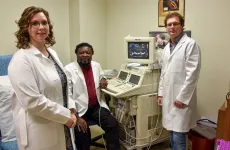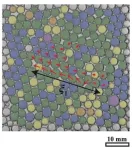(Press-News.org) A method that instructs immune system cells to help repair damaged tissues in the intestine has been developed by researchers at KU Leuven and Seoul National University. This opens the way for more effective treatment of inflammatory bowel disease, including ulcerative colitis and Crohn's disease. The study was carried out on humans and mice.
When functioning correctly, the immune system protects against harmful agents such as bacteria that get into the body. But in conditions such as inflammatory bowel disease (IBD), the immune system attacks the tissues that line the gut, forming ulcers and causing pain and discomfort. Nearly 3.9 million women and 3.0 million men are living with IBD worldwide, and the number of cases is rising.
Since the origin of IBD is unknown, treatments often focus on reducing the immune response in order to limit inflammation and the resulting symptoms. But this also hinders those parts of the immune system involved in repairing the damaged intestine. For example, the white blood cells known as macrophages (literally 'big eaters' in Greek) play a variety of roles in both inflammation and tissue repair. They consume foreign bodies, clear up debris from damaged cells, and release substances that direct other steps in the inflammatory or repair processes.
"Our idea is that the migration of macrophages to the damaged tissue in IBD is essential to stimulate its recovery," explains Professor Gianluca Matteoli, an immunologist at the Translational Research Center for Gastrointestinal Disorders (TARGID) KU Leuven and lead author of the research, published this week in the journal Gut. His team, and that of Professor Seung Hyeok Seok from Seoul National University, set out to test this theory.
When the researchers looked at macrophages in the intestines of a handful of people with IBD, a sub-group of cells able to respond to prostaglandin E2 (PGE2) stood out. Prostaglandins are messenger molecules in the immune system, associated with tissue regeneration.
"If the patients had acute disease, they had a lower amount of these beneficial cells, and if they went into remission, then amounts of macrophages went up. This suggests that they are part of the reparative process," Professor Matteoli says.
To investigate further, the researchers turned to a mouse model for ulcerative colitis, one of the main forms of IBD. The number of macrophages sensitive to the prostaglandin was lower in the model than in healthy mice, but if PGE2 levels were increased, the few sensitive macrophages present responded, releasing a substance that in turn stimulated tissue regeneration.
If the PGE2 receptors on the macrophages were knocked out, making them unable to respond to the prostaglandin, the level of tissue regeneration dropped. But it could be restored by getting the macrophages to swallow a liposome (a bubble of material similar to a fragment of cell wall) containing a substance able to trigger the release of the repair stimulating agent.
"We already knew that prostaglandins were important for inducing proliferation of tissue cells, but this study shows that they are also important for controlling the inflammatory effect, so moving the body from the acute stage where inflammation dominates to the reparative stage," Professor Matteoli says.
The prospects for new treatments lie in liposomes used to jump-start the macrophages into stimulating tissue repair. The technique is well-established as an experimental tool, but applications like this are rare. "This is one of the first times it has been used to produce a beneficial, therapeutic effect," says Professor Seok. However, a lot of work will be needed before it can be used in patients.
The next step is to look in detail at human macrophages at different stages of IBD. "We want to identify other factors that trip the switch that turns macrophages from inflammatory cells to non-inflammatory cells," says Professor Matteoli. "Then, using the liposome technology that Professor Seok has developed, these could be used to target the macrophages and so produce very precise drugs."
INFORMATION:
The project was funded through a scientific cooperation agreement between the governments of Flanders via the Research Foundation - Flanders (FWO) and National Research Foundation of Korea (NRF), and supported by the two universities.
Philadelphia, February 8, 2021 - Early exposure to nutritious foods may help children develop more healthful eating habits, but package labels can make it difficult for parents to understand what they are feeding their young children, according to a END ...
Researchers in South Korea have successfully developed a wearable sensor that can detect illegal drugs in sweat by using nanomaterials technology that amplify the optical signal of narcotics to a flexible, body-worn material. Led by Dr. Ho Sang Jung, the research unit is part of the Korea Institute of Materials Science(KIMS), a government-funded research institute under the Ministry of Science and ICT.
The technology enables fast and highly sensitive drug detection: the sweat patch is attached to the skin for a certain period of time and then irradiated with light for testing. It only takes one minute without requiring additional process.
Traditional drug detection process requires a complex method of extracting suspected drug components from ...
Online searches for mobile and isolated activities can help to predict later surges and declines in COVID-19 cases, a team of researchers has found. Its findings, based on a four-month analysis of online searches, offer a potential means to anticipate the pathways of the pandemic--before new infections are reported.
"This is a first step towards building a tool that can help predict COVID case surges by capturing higher-risk activities and intended mobility, which searches for gyms and in-person dining can illuminate," says Anasse Bari, a clinical assistant professor in computer science at New York University's Courant Institute of Mathematical Sciences ...
AUGUSTA, Ga (Feb. 8, 2021) - Starting with early childhood, otherwise healthy Black people show signs of slightly diminished heart muscle strength and a slightly higher blood pressure than their white counterparts, factors which may put them on a course for early development of congestive heart failure, researchers report.
The take-home message for parents and physicians is that, particularly for populations at high cardiovascular risk such as Black people, a close check should be kept on blood pressure starting in early adolescence, says the corresponding author of the study in Journal of the American Heart Association.
Children ...
Efforts to improve the social success of autistic adolescents and adults have often focused on teaching them ways to think and behave more like their non-autistic peers and to hide the characteristics that define them as autistic. Psychology researchers at The University of Texas at Dallas, however, have been focusing on another approach: promoting understanding and acceptance of autism among non-autistic people.
The researchers published their findings online Jan. 20 in the journal Autism. The study showed that familiarizing non-autistic people with the challenges and strengths of autistic people helped to reduce stigma and misconceptions about autism, but implicit biases about autism were harder to overcome.
Desiree Jones, a psychology doctoral student ...
Beer-Sheva, Israel...February 8, 2021 - A new discovery by researchers from Ben-Gurion University of the Negev (BGU) and its affiliated Soroka University Medical Center shows that medical cannabis may reduce blood pressure in older adults.
The study, published in the European Journal of Internal Medicine, is the first of its kind to focus on the effect of cannabis on blood pressure, heart rate and metabolic parameters in adults 60 and above with hypertension.
"Older adults are the fastest growing group of medical cannabis users, yet evidence on cardiovascular safety for this population is scarce," says Dr. Ran Abuhasira of the BGU Faculty of Health Sciences, one of Israel's leading medical ...
It's well understood that a difficult childhood can increase the likelihood of mental illness, but according to new research from the University of South Australia, a happy and secure childhood does not always protect a child from developing a mental illness later in life.
Conducted in partnership with the University of Canberra, the finding is part of a study published in Current Psychology, which examined how early childhood experiences relate to different developmental pathways, and how these might be associated with poor mental health.
Given that both positive and negative childhood experiences were found to manifest as anxiety or other mental health disorders into adulthood, ...
Tokyo, Japan - Researchers from Tokyo Metropolitan University studied the dynamics of foams. When a drop of water was added to a foam raft, the bubbles rearranged themselves to reach a new stable state. The team found that bubble movement was qualitatively different depending on the range of bubble sizes present. Along with analogies with soft-jammed materials, these findings may inspire the design of new foam materials for industry.
Foams are everywhere. Whether it's soaps and detergents, meringues, beer foam, cosmetics or insulation for clothing and building, we're surrounded by everyday ...
There is an urgent need for guidelines on how schools can use ventilation to reduce the risk of COVID-19 transmission in the classroom, according to doctors at Imperial College London and the headteacher of a secondary school in Pinner, Middlesex. In a commentary published by the Journal of the Royal Society of Medicine, the authors say that improving air quality in classroom spaces should be as important as following government advice regarding social distancing, mask-wearing and hand washing.
The authors point to lessons from the airline industry, where the risk of contracting COVID-19 on a flight ...
6 February: The IMbrave150 trial found median overall survival was 19.2 months in patients treated with atezo+bev vs 13.4 months for those treated with sorafenib alone, the current standard treatment (HR, 0.66 [95% CI, 0.52-0.85]; P=0.0009). Survival at 18 months was 52% with atezo+bev and 40% in patients treated with sorafenib.
All patients in the trial had nonresectable HCC - the most common form of liver cancer - and had not previously been treated with systemic therapy. A total of 501 patients were treated in the multicentre, open label, randomised controlled trial and the new follow-up figures confirm the superiority of the atezo+bev combination over sorafenib in this group of patients with HCC.
Atezolizumab is an immune ...




